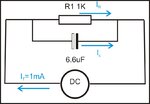rikie_rizza
Full Member level 6

Guys, I need help.
How can I precisely measure the C in RC parallel circuit?
I force 1mA current from a DC source.
One way that I did was to fully charge the cap so it will become a high impedance. After that I measure the R. The voltage is 998mV so this is close enough.
But then I realize that the voltage will never reach 1V..but its okay thou.
Now how to measure the C precisely?
What is the equation correlate V/I with RC?
Discrete please, since s or jω is just a fantasy :lol: